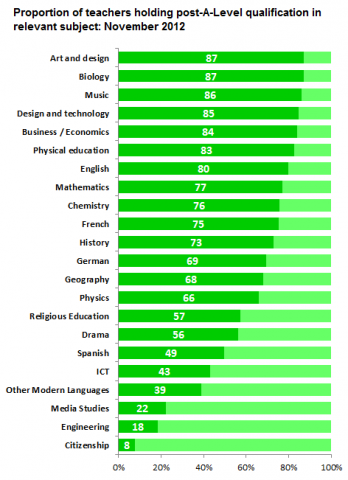Has there been a drop in the number of qualified teachers?
"Under this Government we have seen 6,000 qualified teachers leave the profession since 2010. Now we discover there has been a drop off in graduates coming into the profession, leading to more supply teachers. While this Government insults the teaching profession, pupils are paying the price."
Kevin Brennan, Labour's Shadow Schools Minister, 10 June 2013
"Teachers are better qualified than ever before."
Michael Gove, Education Secretary, 11 June 2013
Michael Gove spoke at the House of Commons today, in a move to get the ball rolling on new reforms which will see both GCSEs and coursework scrapped. The reaction from the Opposition has been mixed. While the former Education Secretary David Blunkett praised the reforms, Labour's Shadow Education Secretary Stephen Twigg voiced some concern.
The issue of how teachers will fit into the new regime has been central to the debate, with the Education Secretary suggesting that teachers are now better qualified than ever.
Join 72,953 people who trust us to check the facts
Sign up to get weekly updates on politics, immigration, health and more.
Subscribe to weekly email newsletters from Full Fact for updates on politics, immigration, health and more. Our fact checks are free to read but not to produce, so you will also get occasional emails about fundraising and other ways you can help. You can unsubscribe at any time. For more information about how we use your data see our Privacy Policy.
Labour has voiced doubts over this. Kevin Brennan - Labour's Shadow Schools Minister- wrote yesterday that the decline in teaching graduates is threatening school standards, adding "the key to good results is to have consistent teaching, from a well qualified teacher."
So what is happening to the number of school teachers?
Have teacher numbers dropped since the Coalition took office?
Yes. In 2010 there were 448,100 school teachers. This number dropped to 442,000 in 2012.
However, as we can see from the chart below there has been a 4,000 rise since 2011. (Source: DfE School Workforce in England)
Is there a shortfall in the number of qualified teachers?

So, what do we mean by a 'qualified' teacher? Teachers in state and special education schools that are under Local Authority control are required to hold an undergraduate degree and to complete an Initial Training Teacher (ITT) course. This allows them to gain Qualified Teacher Status (QTS).
Teachers in independent schools and - as of July 2012 - teaching staff in academies, are not required to hold a QTS.
We know that as of November 2012, the majority of teachers - 96.1% - held qualifications at degree level or higher. These would include Bachelor of Education degrees and Post Graduate Certificates of Education (PGCEs). We also know that this proportion has increased over the past year: in 2011, it was 94.8%.
Last month, we looked into how many teachers hold qualifications which are relevant to the subject they teach, and found that this mostly depends on the subject (see table on the left). While this might suggest that certain subjects are bereft of teachers with specialist knowledge of their subject, we need to be a little cautious, as there is no hard and fast definition of what constitutes a "relevant degree or qualification."
In his blog post, Mr Brennan also writes that there's been a drop in the number of graduates entering the profession. He doesn't cite a source for his claim, but the obvious place to look is the Graduate Teacher Training Registry (GTTR), which in March published applicant figures for full-time and part-time postgraduate teacher training courses.
GTTR revealed that the total number of entrants into postgraduate teacher training fell by 2,583 between the 2012 intake and that of 2013, a change of -6.3%. The largest fall was in Design and Technology, at almost 43%.
While it's true to say that teacher numbers have dropped since 2010, there isn't enough evidence to show that the number of qualified teachers has decreased. In fact, the School Workforce data suggests that the proportion of teachers considered 'qualified' has increased.
---
Flickr image courtesy of Regional Cabinet